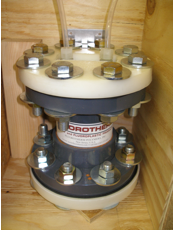Shell and tube heat exchangers are essential components for companies throughout numerous industries, as their heating and cooling properties are required of countless processes. Whether used for petroleum refining or an HVAC system in an expansive manufacturing plant, shell and tube heat exchangers are critical applications for the heating and cooling of liquids. Unlike immersion heat exchangers, shell and tube heat exchangers—which account for more than half of all heat exchangers installed—offer a unique design that allows users to determine whether liquids are heated within tubing or via its surrounding shell.
Given their complexity and key role in industry operations, it's important to know what to look for when selecting shell and tube heat exchangers. That's why we've compiled the following considerations.
Fluoropolymers like PTFE, FEP, PFA and PVDF are critical when heat exchangers interact with potentially corrosive elements. These tubing materials maintain such a strong chemical inertness that corrosion is impossible and the integrity of the heat exchanger can be preserved. A fluoropolymer's ability to prevent leaching is also highly beneficial to heat exchangers working with ultrapure liquids that cannot be compromised. Fluoropolymers like PTFE, FEP, PFA and PVDF further offer high temperature use and flexibility in width and length, all of which are advantageous to creating optimal heat exchanger designs.
Versatile Flow Options
Shell and tube heat exchangers should reflect versatility in design for ideal use and performance. Look for heat exchangers that guarantee flexibility in flow pathways, including counter flow, parallel flow, and cross flow. Changing flows within an exchanger should be a relatively simplistic function to ensure that, should your heat exchanger be warranted for use in a different manner or in a different operation, adjustments can be made seamlessly and you can get the most out of your purchase.
Efficient Cleaning
The design of a heat exchanger should also protect against the accumulation of any unwanted particles or build up. While fluoropolymer tubing will inherently guard against this, other parts of a heat exchanger may need to undergo cleaning on a somewhat regular basis. To ensure thorough cleaning, look for heat exchangers that can be easily disassembled; this will allow for smooth inspection and fine cleaning. Additionally, heat exchangers should not permit flow reversals, which could create undesirable pockets of stagnant gas or liquid.
Thermal Efficiency
Though shell and tube heat exchangers may be the most widely-used heat exchangers on the market, they're not always known for being the most thermally efficient. That's why it's important to seek out the shell and tube heat exchangers that do guarantee superior thermal efficiency. Why? Naturally, the more energy required to heat and operate an exchanger, the more you end up paying. Keep your bottom line in check by turning to a heat exchanger manufacturer like Fluorotherm™ that maintains the right materials, designs, and track record to guarantee thermal efficiency.
Learn more about our shell and tube heat exchangers, as well as our other fluoropolymer products, by visiting us at www.fluorotherm.com.





